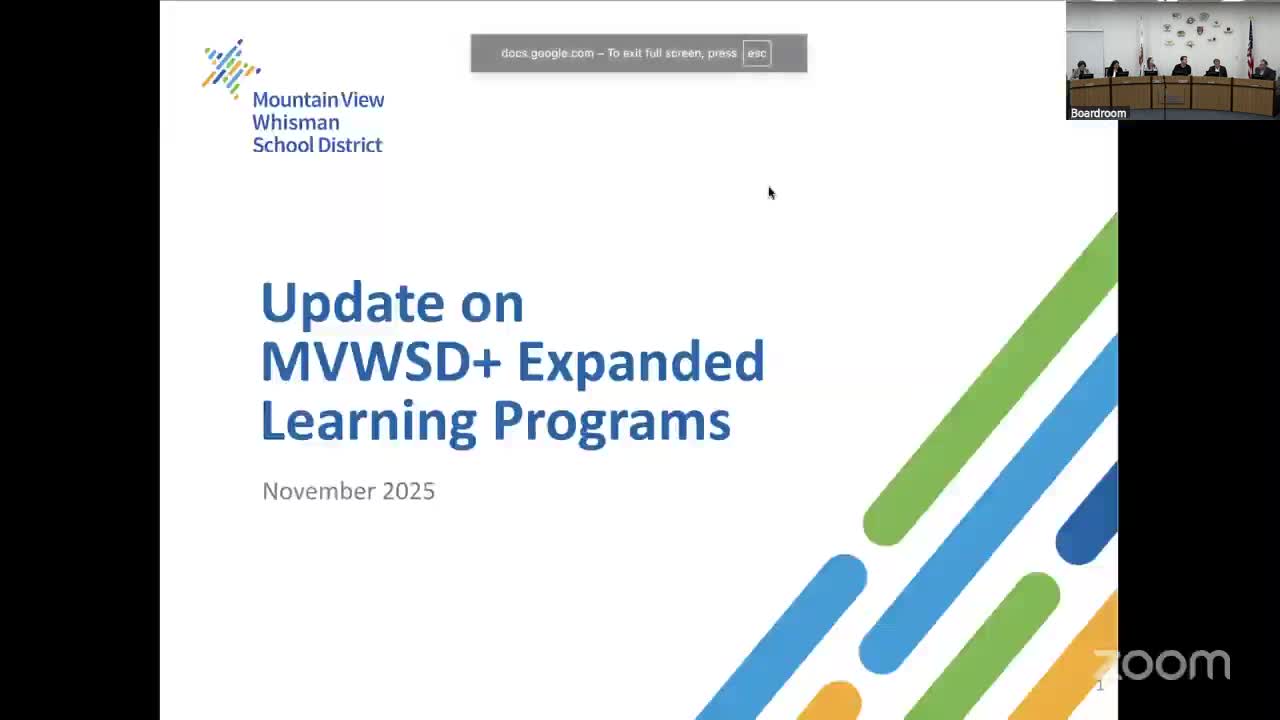District warns of rising costs for expanded-learning programs; staff outline options
November 08, 2025 | Mountain View Whisman, School Districts, California
This article was created by AI summarizing key points discussed. AI makes mistakes, so for full details and context, please refer to the video of the full meeting. Please report any errors so we can fix them. Report an error »

District staff updated trustees on the Mountain View Whisman's expanded-learning programs (ELOP and Beyond the Bell) during the Nov. 6 meeting, saying the district serves about 900 students between the two programs and faces growing budget pressure as carryover funds are exhausted.
Kathy Bauer, presenting in place of an ill colleague, said the district operates two primary after-school funding streams: an After School Education and Safety (ACES) grant and the state Expanded Learning Opportunities Program (ELOP). Bauer said the district currently serves approximately 280 students in Beyond the Bell and about 620 in ELOP, for a total of roughly 900 students across programs.
Bauer gave budget figures: ACES funding is about $469,000 per year; current ELOP funding is about $1.5'$1.9 million (she reported roughly $1,500,000 in current allocations after earlier higher per-pupil rates). Bauer said the district has relied on carryover from earlier ELOP allocations but will exhaust that carryover by the end of the year, creating a need to cover roughly $1.5 million in program costs for 2026'27 if state funding remains at current levels.
Bauer emphasized program differences and constraints: ACES funds are attendance-based and require 85% average attendance to maintain the grant; Beyond the Bell historically prioritizes McKinney-Vento and foster youth and requires five-day attendance; ELOP funds allow variable attendance but require additional health and safety supports and allow expanded-day programming during intersession and summer.
On staffing, Bauer described high turnover, non-credentialed hourly staff, and scheduling challenges that limit the programs' ability to deliver consistent academic intervention. In response, trustees discussed potential approaches, including pairing after-school programs with teacher-led academic supports, using teacher-leaders for check-ins, and exploring contract and program design changes.
Bauer summarized potential revenue options: applying for one-time additional ACES funding (short timeline, apps due Dec. 3), considering a sliding-scale fee for non-unduplicated families (fees may not be charged to socioeconomically disadvantaged students; English-learner families could be charged but are a small share), and examining program reconfiguration between ACES and ELOP to avoid losing attendance-based funds. She said state allocations are not guaranteed until the state completes its tier-1 calculations and that per-student funding has fallen from about $2,000 to about $1,600 in recent years.
Trustees asked clarifying questions about staffing models, whether more credentialed teachers could be brought into after-school work, the magnitude of potential additional ACES funds (staff were still exploring), and whether site-level staffing practices could be aligned to provide tutoring. No board action was taken; staff said they would continue to pursue supplemental one-time ACES funding and present options for 2026'27 planning.
Kathy Bauer, presenting in place of an ill colleague, said the district operates two primary after-school funding streams: an After School Education and Safety (ACES) grant and the state Expanded Learning Opportunities Program (ELOP). Bauer said the district currently serves approximately 280 students in Beyond the Bell and about 620 in ELOP, for a total of roughly 900 students across programs.
Bauer gave budget figures: ACES funding is about $469,000 per year; current ELOP funding is about $1.5'$1.9 million (she reported roughly $1,500,000 in current allocations after earlier higher per-pupil rates). Bauer said the district has relied on carryover from earlier ELOP allocations but will exhaust that carryover by the end of the year, creating a need to cover roughly $1.5 million in program costs for 2026'27 if state funding remains at current levels.
Bauer emphasized program differences and constraints: ACES funds are attendance-based and require 85% average attendance to maintain the grant; Beyond the Bell historically prioritizes McKinney-Vento and foster youth and requires five-day attendance; ELOP funds allow variable attendance but require additional health and safety supports and allow expanded-day programming during intersession and summer.
On staffing, Bauer described high turnover, non-credentialed hourly staff, and scheduling challenges that limit the programs' ability to deliver consistent academic intervention. In response, trustees discussed potential approaches, including pairing after-school programs with teacher-led academic supports, using teacher-leaders for check-ins, and exploring contract and program design changes.
Bauer summarized potential revenue options: applying for one-time additional ACES funding (short timeline, apps due Dec. 3), considering a sliding-scale fee for non-unduplicated families (fees may not be charged to socioeconomically disadvantaged students; English-learner families could be charged but are a small share), and examining program reconfiguration between ACES and ELOP to avoid losing attendance-based funds. She said state allocations are not guaranteed until the state completes its tier-1 calculations and that per-student funding has fallen from about $2,000 to about $1,600 in recent years.
Trustees asked clarifying questions about staffing models, whether more credentialed teachers could be brought into after-school work, the magnitude of potential additional ACES funds (staff were still exploring), and whether site-level staffing practices could be aligned to provide tutoring. No board action was taken; staff said they would continue to pursue supplemental one-time ACES funding and present options for 2026'27 planning.
View the Full Meeting & All Its Details
This article offers just a summary. Unlock complete video, transcripts, and insights as a Founder Member.
✓
Watch full, unedited meeting videos
✓
Search every word spoken in unlimited transcripts
✓
AI summaries & real-time alerts (all government levels)
✓
Permanent access to expanding government content
30-day money-back guarantee

